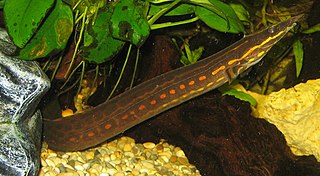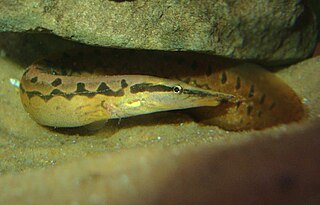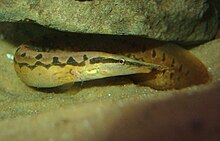
Synbranchiformes, often called swamp eels, is an order of ray-finned fishes that are eel-like but have spiny rays, indicating that they belong to the superorder Acanthopterygii.
The Mastacembelidae are a family of fishes, known as the spiny eels. The Mastacembelids are part of the Order Synbranchiformes, the swamp eels, which are part of the Actinopterygii.
The name spiny eel is used to describe members of two different families of fish: the freshwater Mastacembelidae of Asia and Africa, and the marine Notacanthidae. Both are so-named because of their eel-like shape and sturdy fin spines. These two families are not related: the Notacanthiformes belong to the Superorder Elopomorpha, whose members are characterized by having leptocephalus larvae. The freshwater Mastacembelids do not share this characteristic and are popular specimens in the aquarium trade.

Tropheus is a small genus of at least six species of cichlids endemic to Lake Tanganyika in East Africa. The genus is widespread across all regions of Lake Tanganyika, from Burundi in the north to Zambia in the south. Males and females are relatively similar in color, with only subtle sexual dimorphism in the form of the male's larger size. All species are maternal mouthbrooders, with the females caring for their eggs and fry in their mouths; this characteristic provides their generic name, Tropheus, which comes from the Greek trophos, which means "to nurse" or, according to Boulenger, "one who rears, brings up, educates". The genus is fished lightly by the local population, but has never become a staple food fish due to its relatively small size and its habitat, which enables it to dart between rocks when threatened.

The fire eel is a relatively large species of spiny eel. This omnivorous freshwater fish is native to in Southeast Asia but is also found in the aquarium trade. Although it has declined locally due to overfishing, it remains common overall.

Synodontis is the largest genus of mochokid catfishes. It is the biggest genus within the 10 genera and 190 different species in the family Mochokidae. Synodontis has over 131 different species within the genus. Synodontis are also known as squeakers, due to their ability to make stridulatory sounds through their pectoral fin spines when handled or disturbed. Synodontis make a sound that sounds like squeaking by rubbing their spines together. They do this when they have been frightened or when they become angry. Synodontis may also squeak when they are taken out of the water. These catfish are small- to medium-sized fish with many species exhibiting attractive spotted markings. Some species are also known for naturally swimming belly-up, earning the name upside-down catfish. Some of these species are Synodontis contractus and Synodontis nigriventris. While some of these species are known to swim upside down, another species, Synodontis multipunctatus, is a brood parasitic cuckoo catfish,there are two other species Synodontis petricola and Synodontis grandiops are also called brood parasitic cuckoo catfish.
Macrognathus is a genus of eel-like fish of the family Mastacembelidae of the order Synbranchiformes.
Sinobdella sinensis is an East Asian species of the spiny eel family of the order Synbranchiformes. It is the only species in the genus Sinobdella according to FishBase, but another species, S. dienbienensis, is placed there by Catalog of Fishes.

The zig-zag eel, also known as the tire-track eel, tire-track spiny eel or marbled spiny eel, is a species of ray-finned, spiny eels belonging to the genus Mastacembelus of the family Mastacembelidae, and is native to the riverine fauna of India, Bangladesh, Pakistan, Sri Lanka, Thailand, Vietnam, Indonesia and other parts of Southeast Asia. The species was described as Macrognathus armatus by Lacepède in 1800. Other common names for this popular aquarium species are leopard spiny eel and white-spotted spiny eel. This species is not only a popular aquarium fish but also as a food fish in its country of origin.

Brycinus is a genus of ray-finned fish in the family Alestiidae. Like other "African characids", they were formerly included in the Characidae but are actually somewhat more distantly related Characiformes.

Marcusenius is a genus of the elephantfish group native to Africa. Its members are highly diverse in size, with the smallest species reaching less than 15 cm (6 in) and the largest more than 1 m (3.3 ft).

Mastacembelus cunningtoni is a species of fish in the family Mastacembelidae. It is endemic to the Lake Tanganyika basin, including the Lakes outflow, the Lukuga River as far as the Kisimba-Kilia rapids. It occurs in Burundi, the Democratic Republic of the Congo, Tanzania, and Zambia. The specific name of this fish honours the British zoologist and anthropologist William Alfred Cunnington (1877-1958), leader of the expedition to Lake Tanganyika which collected the type.

Mastacembelus flavidus is a species of fish in the family Mastacembelidae. It is endemic to Lake Tanganyika in Burundi, the Democratic Republic of the Congo, Tanzania, and Zambia. It is found among rocks in shallow, coastal waters to a depth of 6 m (20 ft).

Mastacembelus moorii is a species of fish in the family Mastacembelidae. It is endemic to Lake Tanganyika where it is a secretive species hiding among rocks or in the sediment in the littoral zone. It grows to a total length of 44 centimetres (17 in). The specific name honours the leader of an expedition to Lake Tanganyika, the biologist John Edmund Sharrock Moore (1870-1947).

Mastacembelus platysoma is a species of fish, a spiny eel in the family Mastacembelidae. It is found in Lake Tanganyika which is bordered by Burundi, the Democratic Republic of the Congo, Tanzania and Zambia. The IUCN has listed it as being of "Least Concern".

Mastacembelus ellipsifer is a species of spiny eel that is endemic to Lake Tanganyika in Africa and sometimes kept in aquariums. Although sometimes called the Tanganyikan spiny eel, it is only one of fifteen spiny eel species in the Tanganyikan basin.
Macrognathus pentophthalmos, the Sri Lanka five-eyed spiny eel, is a small species of spiny eel that is endemic to freshwater habitats in Sri Lanka. Described as a common species as recently as 1980, for unknown reasons its population rapidly declined in the following years and there are no recent confirmed records. In 2012, it was listed as "Critically Endangered, possibly Extinct" in the Sri Lankan National Red List, which was matched by IUCN in 2019.
Boulenger's spiny eel is a species of ray-finned fish endemic to India, Myanmar and Thailand, known from Sittaung River, Salween River and Manipur River and possibly Irrawaddy River. Inhabiting large rivers and tributaries, it is consumed by locals but is uncommon in the aquarium trade. It may be threatened by habitat loss for deforestation, dams and overfishing and is harmless to humans.
Macrognathus zebrinus, the zebra spiny eel, is a species of spiny eel endemic to Myanmar, specifically known from the Irrawaddy River, Sittaung River and Salween River and may also occur in Indonesia. It was originally described as Mastacembelus zebrinus before being moved to the genus Macrognathus in 1984 and 1986.

Enteromius is a genus of small to medium-sized cyprinid fish native to tropical Africa. Most species were placed in the genus Barbus.


















